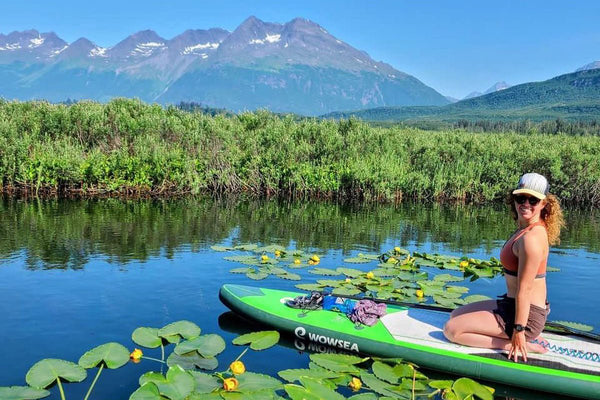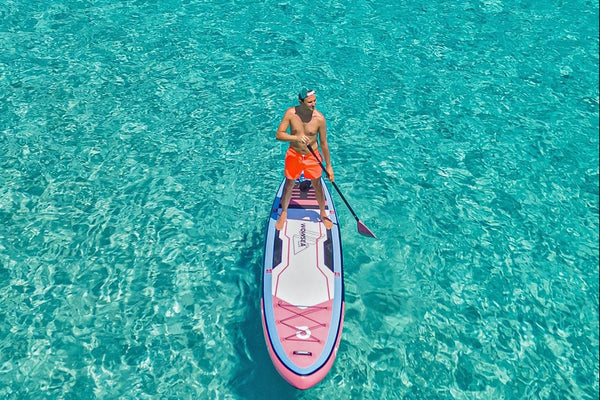
The Environmental Impact of Paddleboarding and How We Can Do to Reduce It
Paddleboarding, also known as stand-up paddleboarding (SUP), is a popular water sport that has gained widespread popularity in recent years. While it provides an enjoyable and healthy way to spend time on the water, it also has an environmental impact. The increasing popularity of paddleboarding can damage aquatic habitats, cause pollution, and cause noise disturbance for marine life. Therefore, it is crucial to understand the environmental impact of paddleboarding and how we can reduce it.
Environmental Impact of Paddleboarding
Can Cause Damage to Aquatic Habitats
Paddleboarding can cause damage to aquatic habitats, particularly in shallow waters such as coral reefs, seagrass beds, and tidal flats. Paddleboards can accidentally touch and damage delicate marine plants and animals, harming the ecosystem's health. Additionally, the disturbance from the paddleboards can cause sedimentation and soil erosion, negatively affecting aquatic habitats.
Paddleboarding Can Contribute To Pollution
Paddleboarding can also contribute to pollution. Plastic bags, bottles, and other debris can be carried by paddleboards and easily fall into the water, adding to the existing marine debris problem. Furthermore, paddleboards are often made of materials that are not environmentally friendly, such as foam and PVC. The manufacturing of these materials involves the use of toxic chemicals and contributes to greenhouse gas emissions.
The Sound Of Paddleboarding Can Disturb Marine Life
The sound of paddleboarding can disturb marine life, particularly in shallow waters where sound travels easily. The noise can interfere with the communication and behavior of marine animals, potentially causing harm to the ecosystem.

Ways to Reduce the Environmental Impact of Paddleboarding
Practice Leave No Trace Principles
Practice Leave No Trace principles when paddleboarding. This means packing out all trash and debris, respecting wildlife, and avoiding habitat damage.
Choose the Right Location and Avoid Paddling in Sensitive Habitats
Choose the right location to paddle board. Avoid paddling in sensitive habitats, such as coral reefs, seagrass beds, and tidal flats. Instead, choose locations that are suitable for paddleboarding and have minimal impact on the environment.
Effective Way to Impact the Environment Positively
This principle is a simple yet effective way to impact the environment positively. This principle is commonly used by individuals who enjoy outdoor activities such as going to the beach, surfing, or paddle boarding. The idea is to pick up at least three pieces of plastic every time you visit an outdoor space, such as a beach or any other natural location. This principle can be applied anywhere you go, even while paddle boarding. If everyone adopts this approach, we can contribute significantly to keeping our natural environment clean and preserving our favorite locations.
To make this process even easier, it is recommended that individuals carry a dedicated bag for collecting and storing trash while they are out paddle boarding. This way, they can give back to nature and help keep the environment clean while enjoying the location's natural beauty. By implementing the "Rule of Three" and taking action to keep our natural environment clean, we can all contribute to making the world a better place.
Reduce Noise Pollution
Reduce noise pollution by paddling quietly and avoiding areas where marine animals are known to frequent. This can reduce the environmental impact and minimize disturbance to marine life.
Buy a Higher-Quality Board
Instead of opting for cheap paddle boards designed for mass production, investing in a quality SUP board built to last is advisable. While low-priced boards may seem budget-friendly, they often fail prematurely and replace other disposable boards. This results in wasted money and contributes to environmental pollution as the discarded boards end up in landfills.
On the other hand, investing in a higher-quality board made from durable materials will cost less in the long run, reduce your environmental impact, and provide better performance and reliability. As a buyer, it is crucial to consciously choose a quality SUP board to ensure a positive and long-lasting impact on yourself and the environment. Additionally, manufacturers have a role to play by producing boards with an extended lifespan and are environmentally responsible.
WOWSEA prioritizes the preservation of our planet's natural beauty and takes our role as responsible members of the paddling community seriously. WOWSEA ensure that our boards are manufactured to meet the highest quality and durability standards, allowing you a long-lasting and enjoyable SUP experience. By making protecting the environment an integral part of your SUP journey, you can have a fulfilling experience while contributing to a cleaner and healthier planet for future generations.

Instead of Buying Bottled Water, Fill a Vacuum Flask
Staying hydrated is crucial during stand-up paddle boarding since it involves spending long hours in the sun and losing fluids. While it may seem convenient to grab a bottle of water from the store and bring it along on your paddle, this contributes to the staggering amount of plastic waste produced every second. In the U.S. alone, 1,500 plastic bottles are consumed every second, with many discarded in landfills or ending up in the ocean, adding to the already-existing garbage vortex.
Instead of contributing to this problem, investing in a reusable and durable water bottle is recommended. Any reusable bottle will be better than disposable ones, but a stainless-steel vacuum-insulated flask is a great option. Not only can you attach it to your board with a carabiner, but it will also keep your water chilled throughout the day. This simple change can help you save hundreds of dollars annually on bottled water expenses while protecting the environment from plastic waste. You can even make some homemade electrolyte drinks for long-distance paddling, compared to supermarket-bottled sports drinks, there are less sugar and sweeteners.
Investing in a reusable water bottle allows you to enjoy cold water, promote sustainable practices, and save money in the long run. So, why not switch today and do your part in reducing plastic waste?
Conclusion
Paddleboarding is an enjoyable and popular water sport, but it has an environmental impact. It can cause damage to aquatic habitats, contribute to pollution, and disturb marine life.
However, by choosing higher-quality paddleboards, practicing Leave No Trace principles, choosing the right location, and reducing noise pollution, we can reduce the environmental impact of paddleboarding. We should take steps to protect our environment so that we can continue to enjoy paddleboarding and other outdoor activities for generations to come.
So, continue your journey of happiness with WOWSEA and LOVE ENJOY MY LIFESTYLE. Stay safe and happy!
Recent Articles

Unwind and Connect with Nature: Small Group SUP Tours in Kawane-cho, Shizuoka
Using high-quality WOWSEA inflatable paddleboards that ensure stability and comfort, you'll feel confident as you explore the peaceful beauty of Sesso Lake.

Must-Have Paddleboarding Gear for 2025
Stay smart, stay safe, and keep those spring paddle vibes 100.

Experience the Enchantment of Alaska's Winter on a WOWSEA Inflatable Paddle Board
Winter after winter, Steve’s turned into Alaska’s ultimate cold-weather paddle warrior. Every trip’s a new episode – maybe catching the northern lights while night-paddling.

7 books that paddlers should read
- Learn about paddleboards, water, and more importantly, yourself!
We hope this list will provide you with some engaging reading material for the winter months or for those days when getting out on the water seems just a bit too challenging.

The Benefits of Spending Time in Nature for Mental Health through SUP
The mental health benefits of spending time in nature through SUP are profound and transformative. From alleviating stress and lifting your mood to enhancing focus, building resilience, and fostering social connections, SUP presents a holistic way to improve mental well-being.

The Rise of Eco-Tourism: Sustainable Travel Options for Your Next SUP Adventure
Embrace ecotourism principles and light the way with your passion for paddleboarding toward a better, more sustainable, fulfilling way of traveling.

Adventures on the Water: Our SUP boarding Diary
We welcome you to share your SUP moments so that more people can see them. The diversity of life is truly reflected in these different experiences of the same things.

Nighttime Paddleboarding: A Personal WOWSEA Summer Odyssey
The true beauty of paddleboarding isn’t just in navigating the waters but in embracing the moments of serenity and connection with the natural world around us.

Share